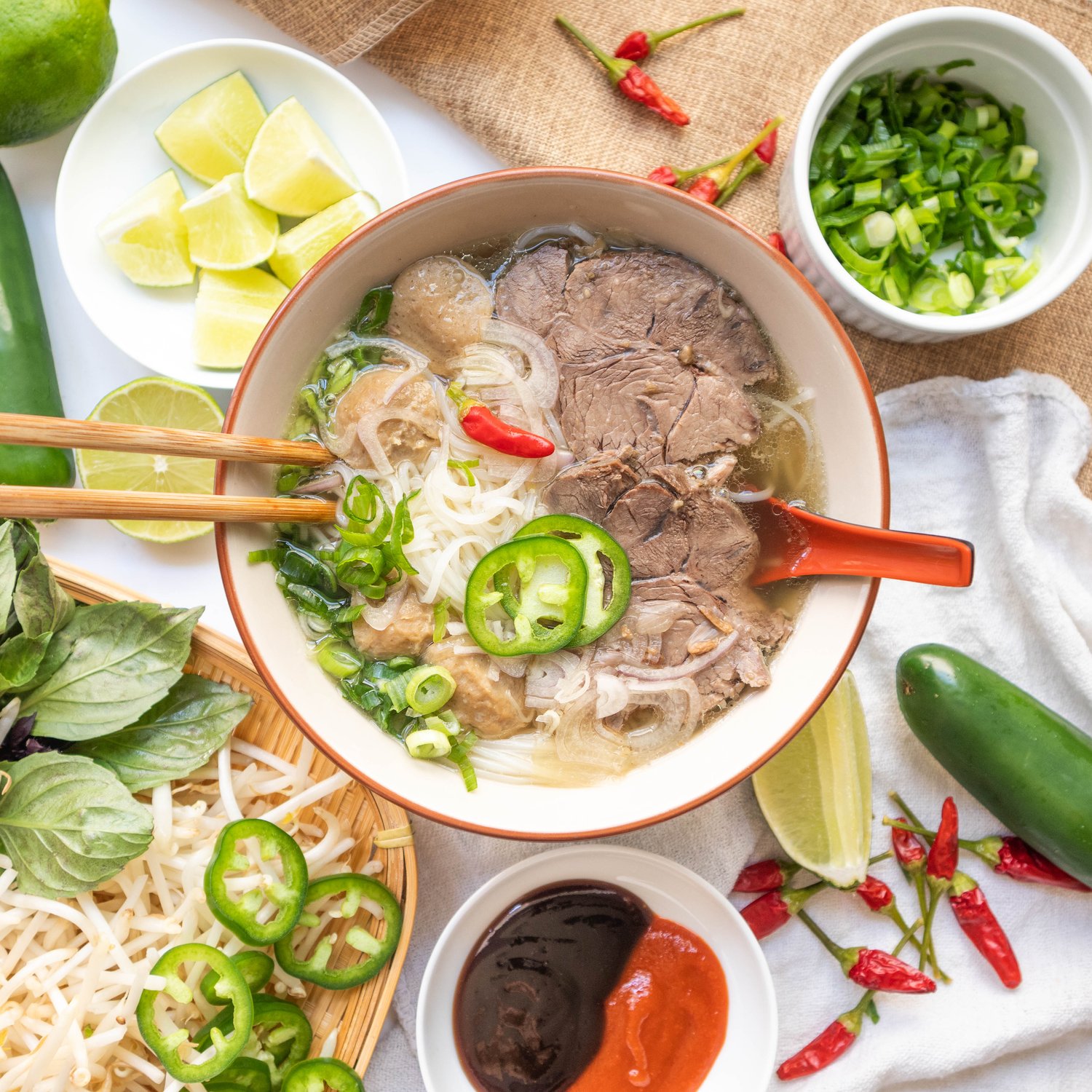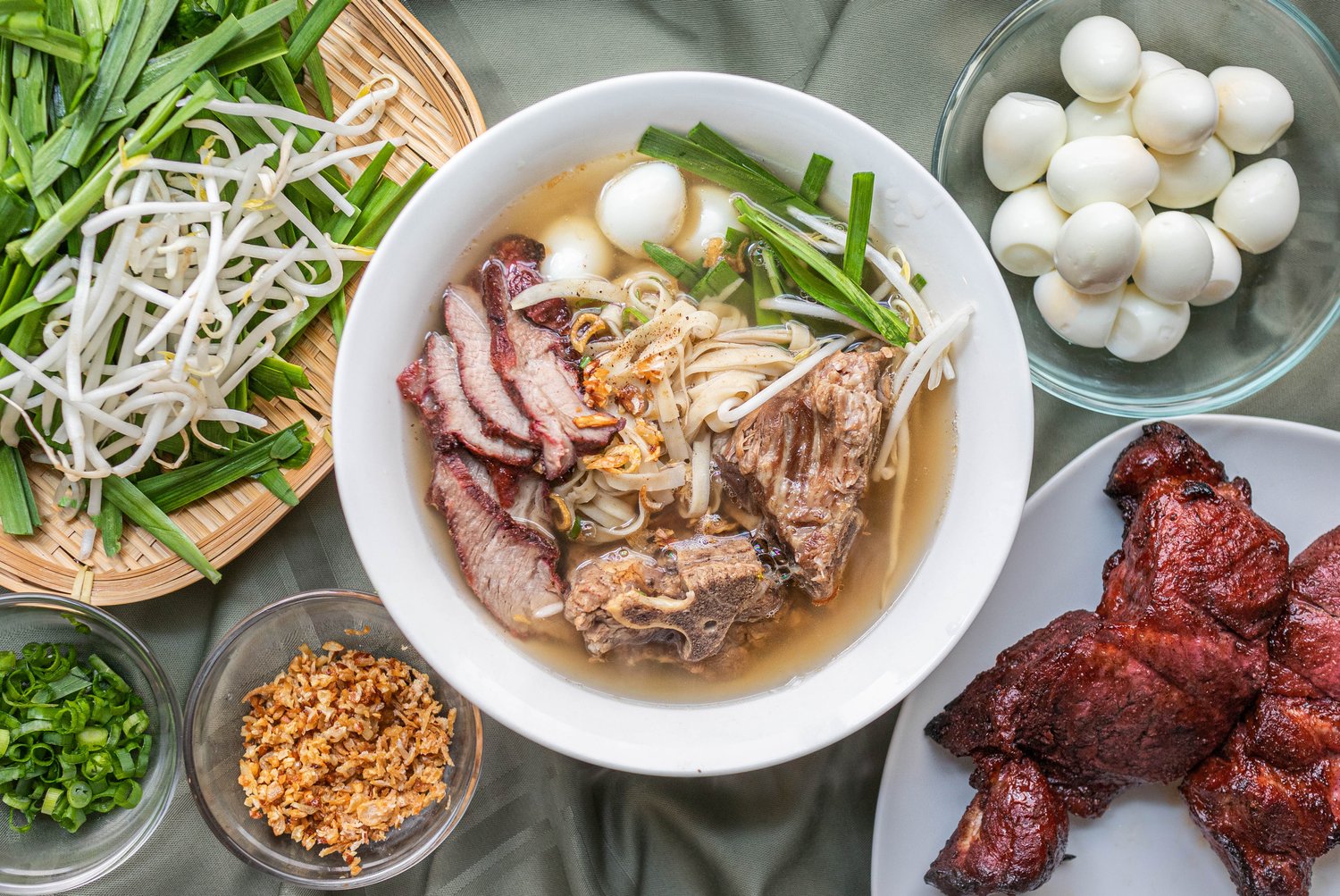Quick and Easy Beef Pho with Beef Ribs (3 Servings Only)
This post contains affiliate links which we are compensated for if a purchase is made. Using links costs you nothing and helps to support the ongoing creation of content. • Jump to Recipe
Quick and Easy Phở with Beef Ribs (3 Servings Only)
Phở is a Vietnamese noodle soup that is traditionally made with either beef or chicken broth, rice noodles, thinly sliced meat, and a variety of herbs and spices.
This recipe is a streamlined version of the classic beef phở. This easy, made-from-scratch pho recipe is perfect for a small family or for one person with a few leftovers.
Not the recipe you are looking for?
Check out this more traditional Vietnamese beef noodle soup recipe (Phở Bò) that serves a crowd or the Instant Pot Beef Phở.
Why You Will Love This Recipe
It's quick to make. The broth only takes one and a half hours to cook. Restaurants’ version takes all day or night. Because are only working with beef ribs and not an assortment of different beef bones and meat, the cooking time is much shorter.
It is a great recipe for beginners. No fancy ingredients here. This recipe uses the bare minimum of ingredients that are easy to find. You can find most things, if not all, at your local grocery stores or online.
It makes only a small portion. This small-batch pho recipe is perfect for a small family or one person with a couple of extra servings for leftovers. You won't have to worry about leftovers clogging up your fridge. Unlike many phở recipes that feed an army, this one is just the right size for a quick and easy meal.
Vietnamese Beef Noodle Soup (Beef Phở)
What You Will Need
Beef Spare Ribs — The only meat we are using. Beef spare ribs serve two purposes. They are cooked until tender and flavorful to provide a rich phở broth. They are also used as the meaty toppings in the finished bowl. Make sure to pick meaty beef ribs so that you have enough meat to enjoy with your phở.
Alternatively, you can use oxtail, a more expensive option but an equally tasty and meaty bone for phở broth.
Yellow onion — This adds an amazing and traditional aroma. It also adds a natural sweetness to the broth.
Ginger — It can't be an Asian dish without ginger. Ginger adds a distinct aroma and very subtle spicy zing to the broth.
Beef ribs, ginger and yellow onion
Phở Spices — Phở is made with spices that give the broth its signature aroma. This includes star anise, cardamom, cassia cinnamon also known as Chinese cinnamon, fennel seeds, coriander seeds and cloves. To simplify this recipe, I'm using a tea bag version of these ground up spices. Spices may vary slightly depending on brand. I’m using Pho Hoa brand, which contains four tea bags.
Phở spice packet. This box contains four tea bags.
Flat Rice Noodles — These are the traditional noodles used in phở. They are primarily made from rice flour and water. You can find these in the refrigerator section of many Asian/Vietnamese grocery stores. If you don’t have an Asian grocery store for the fresh noodles, my favorite dried alternative is Three Ladies rice noodles.
The fresh rice noodles I’m using. This is the smallest bag of rice noodles that I can find. This bag yields three regular servings or four small servings.
Equipment You Will Need
A large pot with a lid — To prepare this recipe, you'll need a large pot with a lid. Although it only serves three people, the pot must be spacious enough to prevent water overflow when adding beef ribs, which are pretty big and other ingredients. I recommend using a stock pot of at least 5 quarts.
Metal Colander — When making phở, you need a colander to drain the noodles after blanching. One of my favorite kitchen items is this metal colander that my husband got me … that I said I didn’t need because I have many other plastic colanders…that I now use almost everyday. With this metal colander, I can blanch the entire noodle package and drain the whole pot through the colander without worrying about melting or plastic contamination.
Fine Mesh Spoon — A clear phở broth is a highly prized broth. Use a fine mesh spoon to help you skim the impurities and small bone bits that may cloud the broth.
Broth Seasonings
Fish sauce —This adds a salty umami flavor to the broth. Fish sauce is a fermented fish product that is a common ingredient in Vietnamese cuisine. There are many different brands of fish sauce and each has its own varying level of saltiness. My favorite brand is Three Crabs fish sauce.
Salt — Too much fish sauce can make the broth pungent. Sea salt is here to save the day.
Sugar — A little sweetness is needed to round out the flavors. I'm using regular granulated white cane sugar so it doesn’t darken the broth.
MSG (Optional) — You can stop with fish sauce, salt, and sugar. The broth will be just fine with these seasonings. But if you want to elevate the dish and make it more like your favorite restaurant version, add a little MSG to the mix.
MSG, or monosodium glutamate, is a flavor enhancer that is commonly used in Vietnamese cuisine and naturally occurring in many foods. It gives the broth an extra umami flavor, which is a savory, meaty flavor.
Optional Garnishes & Vegetables
Green Onions — Green onions are thinly sliced and added to the pho just before serving for a beautiful finish.
Limes — A squeeze of fresh lime is a must. It provides the acidity to complement the flavorful yet fatty beef broth, and brings all the flavors together. If you don’t have limes, use lemons. Regular distilled white vinegar also works well.
Thai Basil — Thai basil is a type of basil that is native to Southeast Asia. It has a strong and slightly sweet flavor that pairs well with phở. It also adds an amazing fresh aroma to the finished bowl. If can't find this Thai basil, substitute with any other basil variety.
Red Chili Peppers — A beautiful red garnish that adds a nice kick of heat for those who like their noodle soup spicy.
Hoisin sauce and Sriracha chili sauce — Optional condiments to add to the bowl or to use as a dipping sauce for the beef ribs. Hoisin sauce is a thick, dark sauce that adds a rich and slightly sweet flavor to complement the savory phở broth. Sriracha chili sauce is a less spicy alternative to the actual chili peppers.
How to Make It
Step 1: Toast the aromatics
Toast the onions and ginger right in the stock pot. To do this, heat a medium pot with a heavy-bottom over medium-low heat. No oil is needed. Add onion halves and sliced ginger. Toast until they are browned on both sides, about 6 minutes per side.
Toasting onions and ginger right in the stock pot
Step 2: Make the broth
Add water and beef ribs. Bring the pot to a boil, then reduce heat to low, cover and simmer for 1.5 hours.
Making phở broth. Impurities will float to the top, which is normal. Ignore for now.
Finished phở broth. Unstrained.
Add spice bags and continue simmering for 30 minutes covered or until the ribs are fall-of-the-bone tender. Remove the beef ribs from the broth and set them aside as a meaty topping.
Remove the spice bags, onions, and ginger.
Use a fine-mesh strainer, remove all the little bits. If you want a much clearer broth, strain the whole pot through a fine-mesh sieve into a new pot.
Cooked dinosaur size beef ribs. Top each bowl with one or two ribs.
Strain broth to remove all the impurities for a clear and beautiful broth.
Excess oil in phở broth. Make sure to remove.
Beef ribs contain a lot of fat. There will be a thick layer of fat floating on top of the finished broth.
I highly recommend skimming the surface with a large spoon to remove the excess fat.
Alternatively, place the whole pot in the fridge. The fat will solidify at the top and appear white in color, which you can then easily remove in large chunks. Just don’t remove all as fat is flavor!
Season broth to taste with fish sauce, sugar, salt, and MSG.
Step 3: Prep the other ingredients
Cook the rice noodles per the package instructions. Prepare all the garnishes and wash the vegetables, if using.
Step 4: Assemble and serve
Divide the rice noodles into three regular bowls or four small ones. Top with beef ribs, broth, your favorite garnishes and vegetables. Serve immediately for best results.
How to assemble a phở bowl
Vietnamese Favorites
If you enjoy this recipe, check out these other popular Vietnamese recipes:
Ginger Chicken
Roasted Lemongrass Chicken (Great for Banh Mi)
Fresh Spring Rolls with Peanut Sauce
Caramelized and Braised Catfish (Ca Kho)
Steamed Pork Buns with Quail Eggs (Banh Bao)
Popular Beef Recipes
Beef Stew (Bo Kho)
Spicy Beef Jerky
Ground Beef Wrapped in Wild Betel Leaves (Bo La Lot)
Stir Fried Morning Glory with Beef (Rau Muong Xao)
Shaking Beef (Bo Luc Lac)

Quick and Easy Beef Pho with Beef Ribs (3 Servings Only)
Ingredients
Instructions
- Heat a medium pot with a heavy-bottom over medium-low heat. No oil is needed. Add onion halves and sliced ginger. Toast until they are browned on both sides, about 6 minutes per side.
- Add water and beef ribs. Bring the pot to a boil, then reduce heat to low, cover and simmer for 1.5 hours.
- Add spice bags and continue simmering for 30 minutes covered or until the ribs are tender.
- Remove the beef ribs and set aside as a meaty topping. Remove the spice packets, onions, and ginger.
- Use a fine mesh spoon to help you skim the impurities and small bone bits that may cloud the broth. If you want a much clearer broth, strain the whole pot through a fine-mesh strainer into a new pot.
- Beef ribs contain a lot of fat. There will be a thick layer of fat floating on top of the broth. I highly recommend skimming the surface with a large spoon to remove the excess fat. Alternatively, place the whole pot in the fridge. The fat will solidify at the top and appear white in color, which you can then easily remove in large chunks. Just don’t remove all as fat is flavor!
- Season broth to taste with fish sauce, sugar, salt, and MSG.
- Cook the rice noodles per the package instructions. Divide the rice noodles into three regular bowls or four small bowls. Top with beef ribs, hot broth, and garnished with thinly sliced green onions and chili peppers.
- To enjoy, squeeze a wedge of lime. Add a little of hoisin and chili sauce into the bowl or serve it on the side as a dipping sauce for the ribs.



















